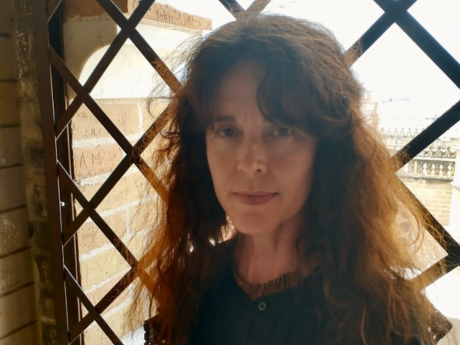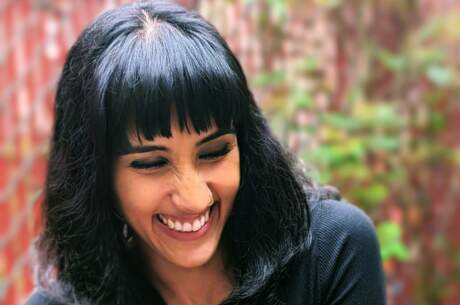In Their Own Words
Karla Kelsey on “On Certainty”

from On Certainty
Regardless of appearance there is birth and there is death
There is being and non-being
Interior and exterior
Disrobing with one hand, shielding with the other my sex, after the first
night with the Tyrant I woke to my body furred as a leopard
Giving rise to new gestures and abilities of violence
Around my right thigh, a garland of bees
So many things needed saying in the garden but it was plummeting and
scorching
Whether we are human or animal, animal or machine, machine or
information: all at once permeated with doubt
.
To run my hand once again over the Philosopher’s sentences
To hold to cold marble my flushed cheek
.
On screen a woman walks through a museum in an advertisement for
sepia washes, bleached-out fields of white evoking the spirit of
Muybridge
The archive of Western art pillaged for virtual reality skins
The foundation of a photograph indistinguishable from its referent: the
branded photograph of a hide marked with a cattle brand
Today I wear a body by Vermeer, round face, seashell ears with their
attendant pearls garnered from Dutch colonial waters
And for my apartment: walls and windows gridded with Malevich’s Black
Square
Wearing the self-portrait of Parmigianino I did not feel like
Parmigianino, and wearing Courbet I did not feel like Courbet,
but with Schiele I felt his self-portrait’s wracked body, organic
twist
Stop playing games Phryne, the Tyrant said, returning the apartment
back to the severe elegance of Augustan Third Style, and don’t
think for a moment, he said, I’ll let you alone if you wear the
body of a boy
.
Now that summer is here there is little planting to be done
The walls when he leaves an undulating sea
Reprinted from On Certainty (Omnidawn, 2023) with the permission of the author.
On "On Certainty"
On Certainty is a speculative allegory that tells a story of power and decline through three central characters: the Tyrant, the Philosopher, and an unnamed female narrator who had once been the Philosopher’s student. When I began writing the book I had no intention of telling a tale. I had not intended to describe a setting haunted by climate catastrophe so great that large swathes of the country have become uninhabitable, animatronic animals have begun to replace the living, and virtual reality threatens to eclipse the real. I had no intention of appointing the Tyrant as leader. I had no interest in exposing the Philosopher’s deep flaws. I certainly had no desire to assign my narrator the role of philosophy professor, ambivalently carrying on the Philosopher’s legacy. That she becomes mixed-up with the Tyrant: this I had not foreseen.
In truth, the development of any plot at all was a surprise to me. In the summer of 2015 I had begun writing in conversation with two lushly illustrated books that I had found at a library sale—Gardening Week by Week from 1975 and Matter, a Time-Life science book from 1969.[1] Matter was compelling for its granular view of materiality. Gardening Week by Week was stunning for its gorgeous images accompanied by startling recommendations for the use of pesticide now known to be toxic. Alongside these, I was reading Ludwig Wittgenstein’s On Certainty and spending long hours in the Metropolitan Museum of Art. Initially, this research was loosely woven together as a series of decisive statements about art and nature counterbalanced by lyrical descriptions that often unsettled them. The book unfolded in an abstract synthesis akin to Anni Albers’ textiles or Steve Reich’s slow harmonic rhythms.
I don’t recall the exact moment that story entered the composition, but when it did the research-based threads began to twist and knot with imagination. Figures began to appear. Specific voices erupted in dialogue. The first plotted draft seemed fantastical, although by the fall of 2016 the book, which had fully developed its narrative, began to sound prophetic. I’m afraid that in 2024 On Certainty reads more like a documentary than speculative fiction. Would I have written the book had I known this would be the case?
One of the figures that became important to On Certainty
is Phryne, a real woman from the fourth century BCE who came (or was more likely enslaved and brought) to Athens to participate in the sex trade. She eventually became one of the wealthiest hetaira (courtesans) in Classical Greece and is best known for her trial for impiety.[2] Phryne was acquitted when she bared her breasts to the all-male jury, or so the story goes. What is now known about Phryne comes by way of fragments and depictions, such as the sculpture Aphrodite of Knidos, made by her lover, Praxiteles. Famous for being one of the first life-sized representations of a female nude, the original is now lost, and the figure is known only via its many copies.[3] Other portrayals of Phryne important to On Certainty are the painting from 1861, Phryne Before the Areopagus, by Jean-Léon Gérôme and Jeff Koons’ 2017 Phryne,
a virtual reality version of his enormous, glossy Seated Ballerina.
When the story of Phryne and many of these images began to circulate through On Certainty, I found that the narrator had become a type of Phryne. She is appointed to the role of one of the Tyrant’s mistresses and, as we see in the excerpt above, her features begin to transform, taking on characteristics from artworks as well as from the non-human world. As such, the narrator’s journey mirrors Phryne’s, navigating the precarious intersections of power, sexuality, and identity. In the end, it is my hope that On Certainty transcends its dystopian narrative, offering a vision of survival and metamorphosis in a fractured world.
[1]
Field, Xenia. Gardening Week by Week. (New York: Crescent Books, 1975); Lapp, Ralph E. Matter. (New York: Time Life Books, 1969).
[2]
Funke, Melissa. Phryne: A Life in Fragments. (London: Bloomsbury, 2024), 87.
[3]
Squire, Michael. The Art of the Body: Antiquity and Its Legacy. (Oxford: Oxford University Press, 2011).



